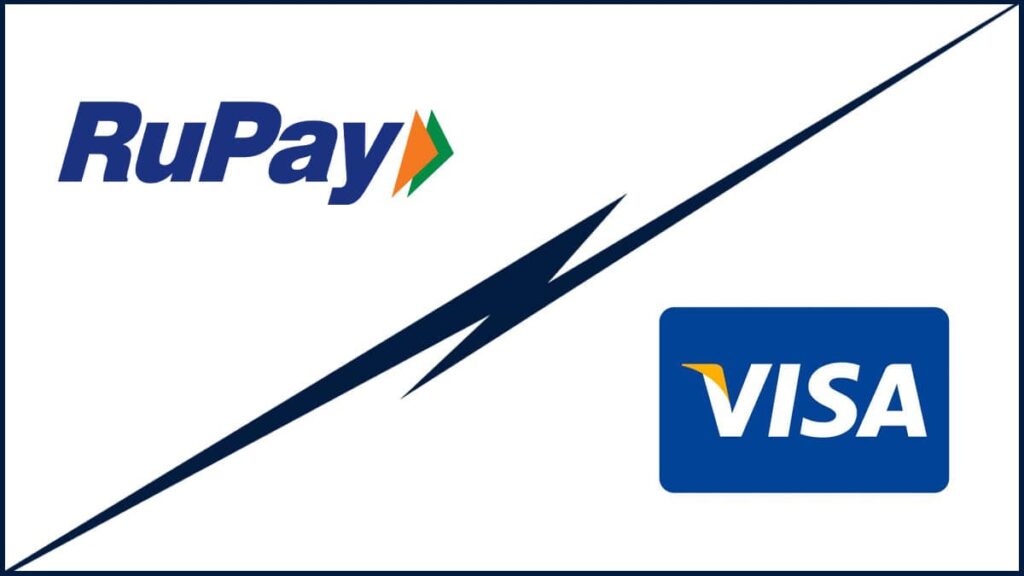Traditionally there are two types of cards which is connected with a financial service provided by the banks and other NBFCS.
In India, the card market is dominated by a few players only i.e., Mastercard, VISA, and Rupay card. All credit and debit cards use these networks only.
Mastercard and VISA are foreign firms based off of USA and Rupay is a domestic alternative that seems to become a market leader in India.
Since these cards act as a backbone for both credit and debit cards, you must choose the option that is most beneficial for you.
You can ask your bank to provide you with the card which you can use the most. For this, however, you’ll need to understand the difference between them.
In this article, we will discuss the difference between RuPay, Mastercard, and VISA Card, what is the payment network, it’s functioning, and much more.

What is Payment Network Card?
A payment network card is a card issued by the banks which is connected to a payments network i.e. VISA, Rupay, and Mastercard. The connection allows you to transact over this network and get your payment done easily.
These cards are linked to a specific payment network, which enables the transfer of funds from the cardholder’s account to the merchant’s account during a transaction.
Payment network cards come in different forms, such as debit cards, credit cards, and prepaid cards. Each type of card offers varying functionalities and benefits.
Debit cards are directly linked to the cardholder’s bank account, allowing for real-time deduction of funds when making purchases.
Credit cards, on the other hand, provide a line of credit issued by the card issuer, allowing the cardholder to borrow money for transactions with the obligation to repay it later.
Prepaid cards are loaded with a specific amount of money in advance and can be used until the balance is depleted.
These payment networks establish the infrastructure that connects cardholders, merchants, and financial institutions, ensuring the secure transfer of funds with accountability to all the stakeholders.
How does a Payment Network Card work?
When making a purchase, the cardholder presents the payment network card to the merchant. The merchant swipes, inserts, or taps the card on a card reader, or in the case of online transactions, the card details are entered into a secure payment gateway.
Next, the merchant’s machine or the online payment system sends a request to the bank or company that issued your card through the payment network. This is to check if you have enough money or credit to make the purchase.
The bank then receives the request and checks if everything is okay. They make sure it’s a valid transaction and that you have enough funds or credit limit. They want to make sure no one is using your card without your permission.
After that, the bank sends a response back to the merchant through the payment network. It says whether the transaction is approved or not. If it’s approved, the merchant can complete the sale.
Once everything is finalized, the payment network helps transfer the money from your account to the merchant’s account. This happens really quickly, usually within a few seconds.
Finally, the bank and the merchant’s bank settle the payment amount, including any fees or charges. They do this through the payment network, making sure everything is sorted correctly.
This whole process is designed to be quick and secure, so you can make your payment easily and without any worries. Just remember to keep track of your spending and use your payment network card responsibly.
Comparison Between VISA/Mastercard & Rupay
The following is a detailed comparison between VISA/Mastercard & Rupay-
| Criteria | VISA/Mastercard | RuPay |
| Origin and Background | International payment networks | Indigenous card payment network in India |
| Acceptance Network | Globally accepted | Widely accepted within India |
| Coverage | Extensive network of merchants worldwide | Focus on acceptance within India |
| International Acceptance | Accepted in numerous countries globally | Limited international acceptance |
| Cost-effectiveness | Generally higher fees and charges | Cost-effective and affordable |
| Card Variants | Various card types and offerings | Variants available for different needs |
| Additional Features and Benefits | Rewards programs, perks, and benefits | Special features and tie-ups |
| Rural and Semi-Urban Penetration | Relatively lower | Increased focus and penetration |
| Availability | Widely available | Availability in specific regions |
| Accessibility | Easy access for international travel | Mainly suited for domestic use |
FAQ
Yes, VISA/Mastercard are widely accepted in India, allowing cardholders to purchase at various merchants and online platforms.
Yes, many international banks allow Rupay payments however, the network is not widely spread across the world because RuPay cards are primarily designed for domestic use within India.
RuPay is known for its cost-effectiveness and affordability compared to VISA/Mastercard, which often have higher fees and charges.
Yes, RuPay cards are accepted for online transactions within India and some international websites, allowing users to shop on e-commerce platforms and make online payments.
Yes, VISA/Mastercard have a broader availability worldwide, while RuPay is mainly issued by Indian banks and targeted towards the domestic market.



